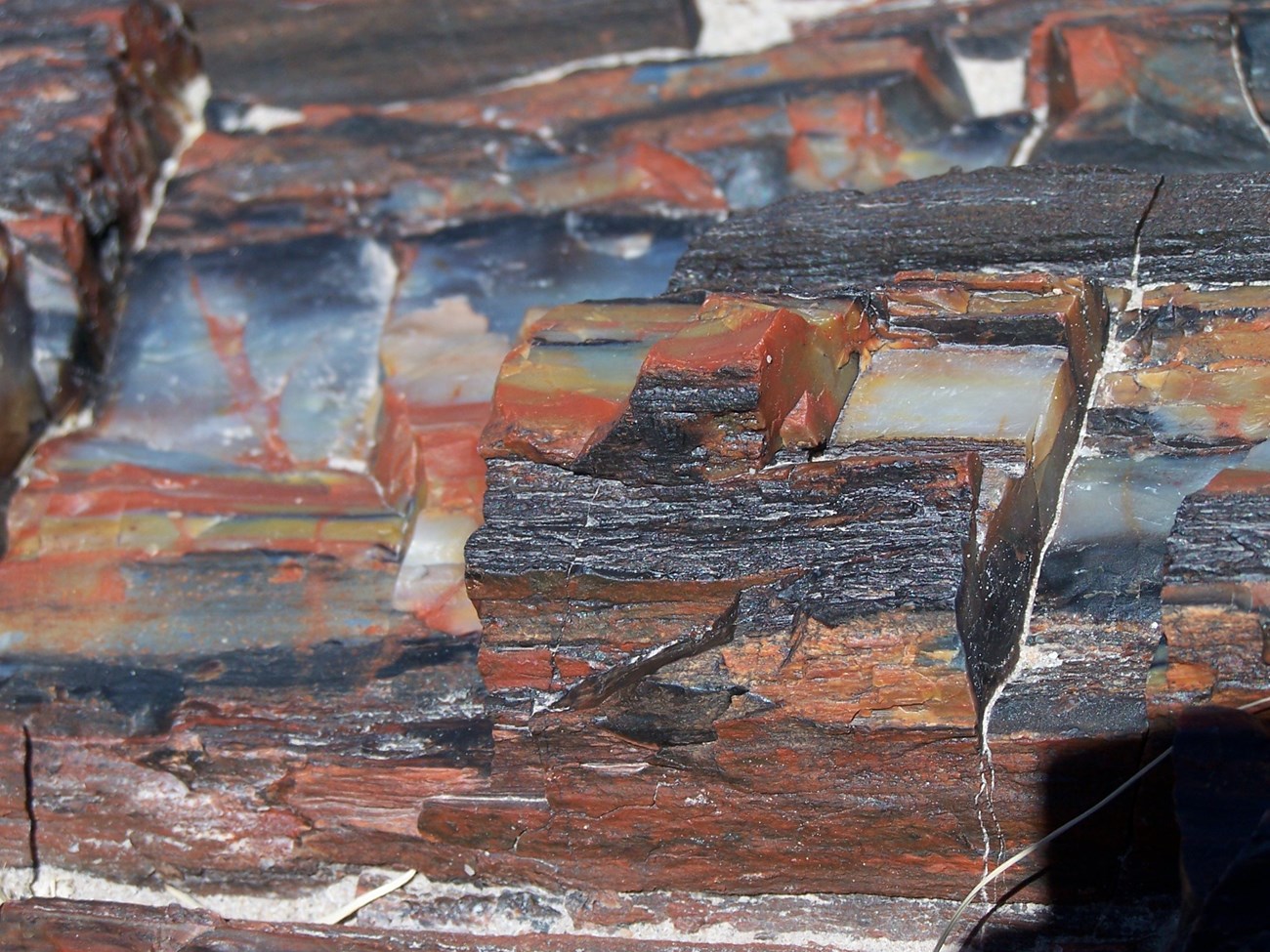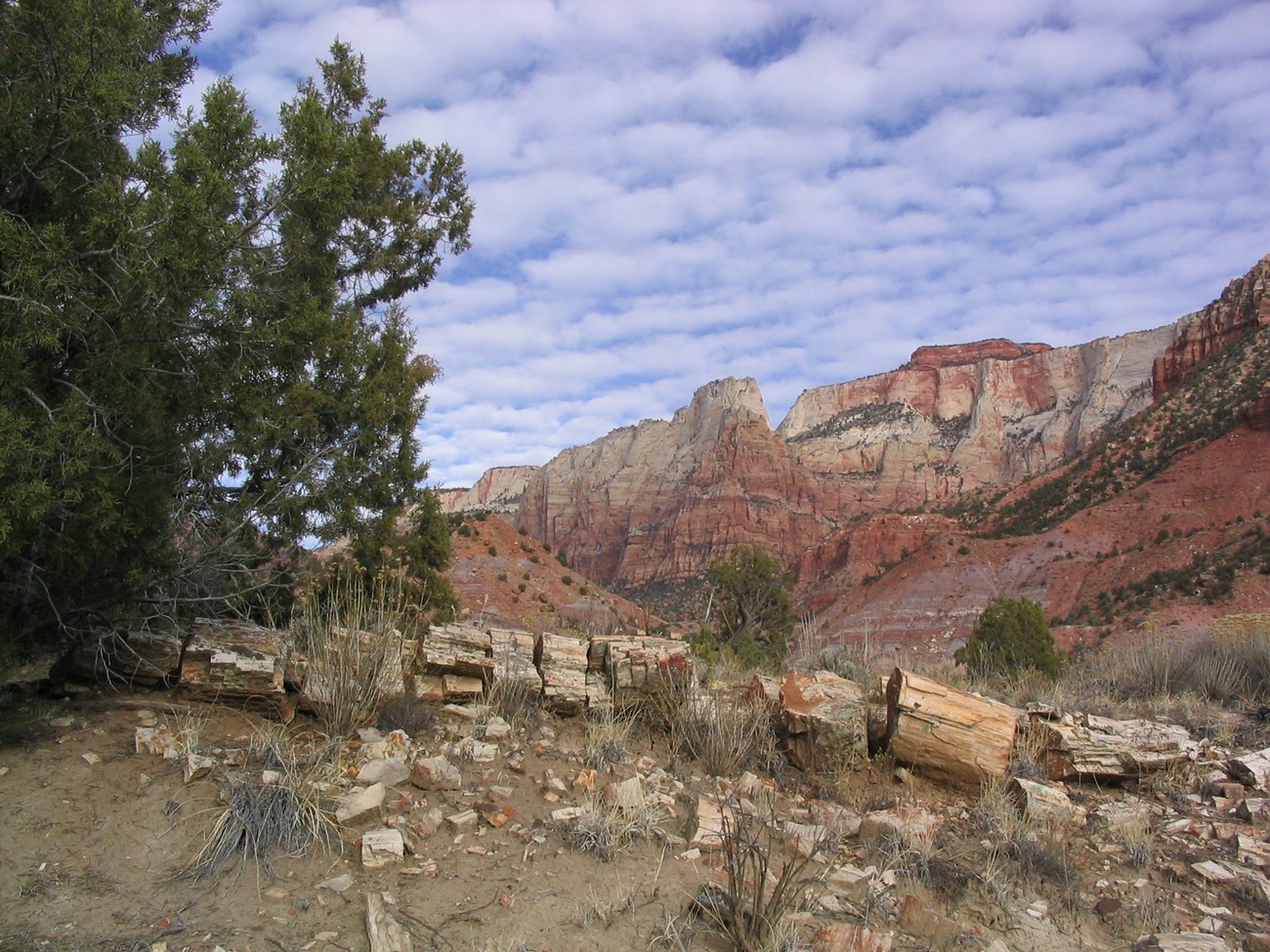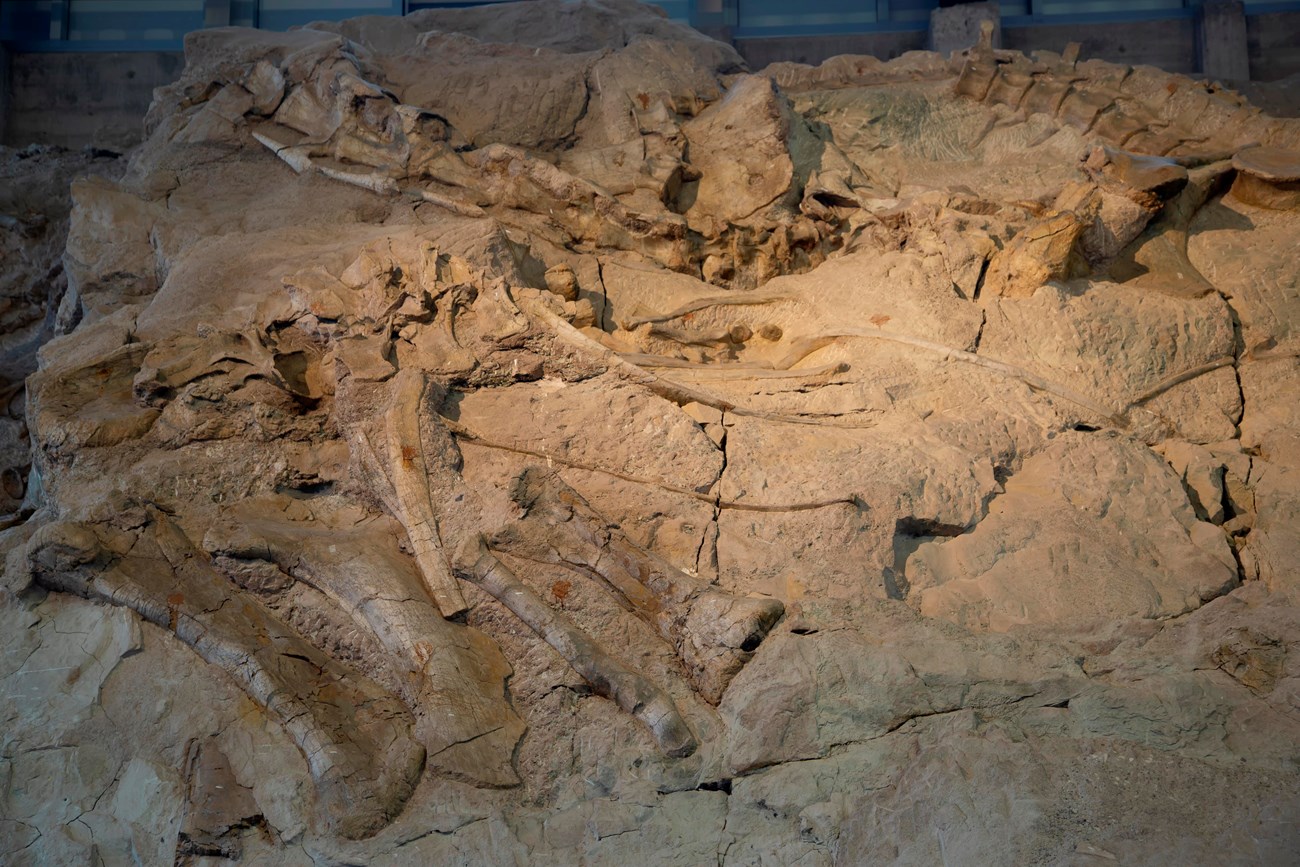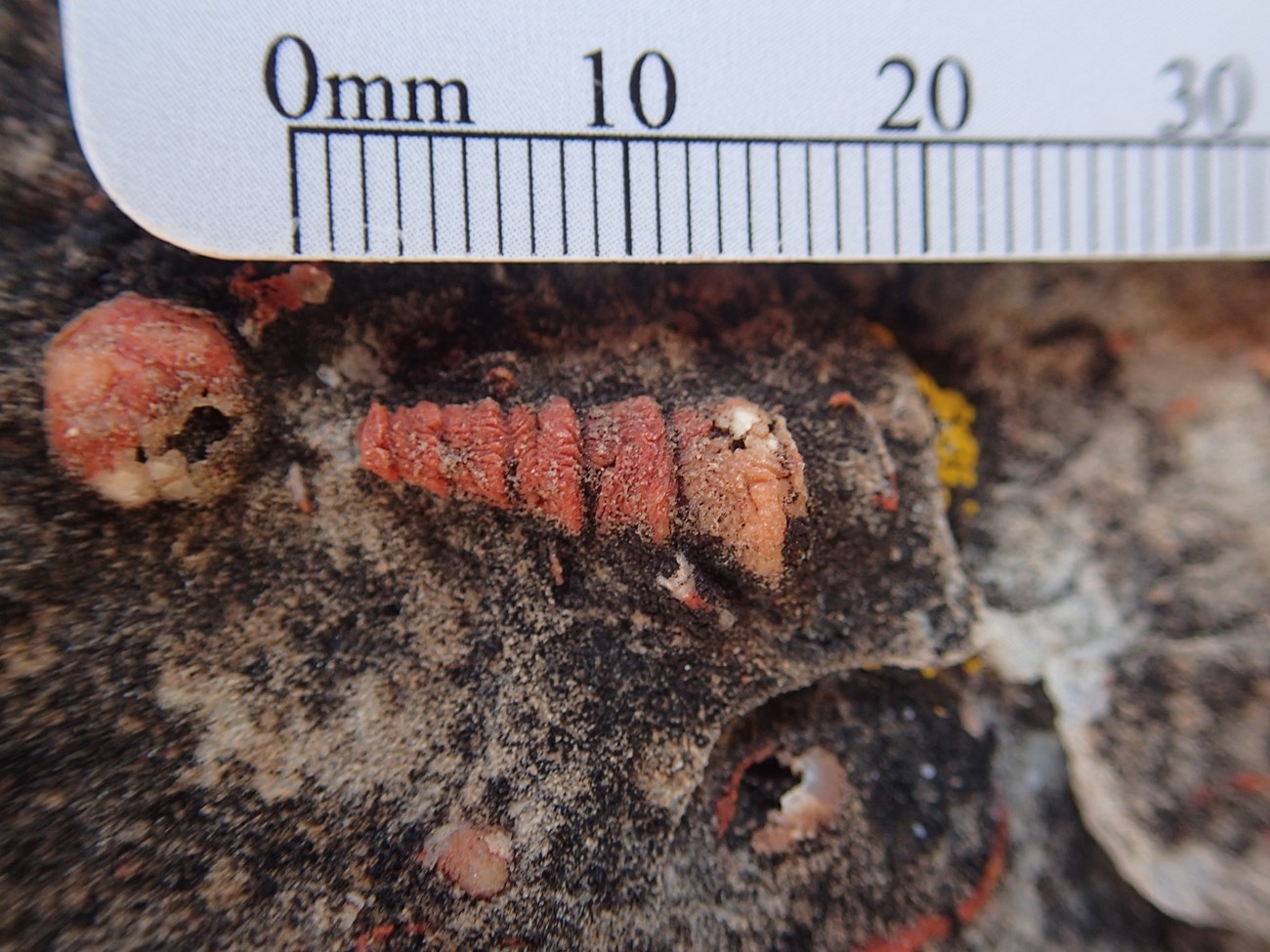Last updated: August 16, 2024
Article
Permineralization and Replacement

NPS photo.
Introduction
Permineralization and replacement are among the most common processes that have led to the preservation of fossils found in national parks. Both are especially important in the fossilization of wood, bone, and shell materials. They may occur separately from one another (e.g., permineralization can occur without replacement, and replacement can occur without permineralization), but the two processes most often happen together.
Permineralization
Permineralization is the infilling of natural pores in original organic material by minerals. It occurs when groundwater containing silica or other ions flow through small (or even microscopic) pores in buried wood, bone, or shells. The presence of organic material can create a chemical environment that causes the dissolved ions to precipitate out of solution leading to permineralization.
Permineralization forms a three-dimensional internal mold of the original organic tissue, sometimes preserving details at the microscopic or cellular level. Permineralized fossils usually retain the original shape of the material that was fossilized (versus being flattened like in some other fossils). Permineralization most often occurs in hard parts (wood, bone, or shell), but may also take place in soft tissue. A permineralized fossil is denser and heavier than the original organic material because its pores have been filled by silica or other minerals.

NPS photo.
Replacement
Replacement is the substitution of inorganic minerals for the original hard parts of organisms that have been dissolved away. Replacement involves a change in the mineralogy of an organism’s hard parts, unlike recrystallization which involves minerals of the same chemical composition.
Learn More
Petrification
Petrification (also known as petrifaction) is a term sometimes used to describe permineralization and/or replacement. The word’s Latin roots (“petra” meaning “rock” and “facere” meaning “make”) reveal that petrification means to “turn into stone.”
Paleontologists usually prefer using the terms permineralization and replacement instead of petrification because they describe the fossilization processes versus its stony outcome. Further, the term petrification can perpetuate the common misconception that all fossils are petrified, when, in fact, many fossils such as trace fossils, leaf impressions, and preserved remains like those in amber have not been “turned to stone.” Not even all fossil wood has been petrified, as some has undergone carbonization instead.
Types of Permineralization and Replacement
Overall, there are three major types of permineralization and replacement based on the composition of the minerals that are involved:
-
Silicification: The infilling of pore spaces and/or replacement with silica (SiO2).
-
Pyritization: The permineralization and replacement processes that involve pyrite (iron sulfide, FeS2).
-
Carbonate mineralization: Carbonate (CaCO3) mineralization can occur in bone fossils. It also may occur in plant tissues in peat deposits.
Silicification
Silicification is permineralization and/or replacement by silica. Silicification is the most common type of permineralization and replacement, particularly in fossil wood and bone. Carbonate shells of invertebrates such as mollusks, brachiopods, or crinoids can also be silicified.
Silica is widely available in the circulating groundwater present during diagenesis (the processes that occur after deposition as sediment transforms into sedimentary rock) when fossilization occurs. The source of the silica is the weathering of major rock-forming minerals, volcanic ash, and/or derived from skeletal elements of some marine organisms like some types of sponges or zooplankton.
Silica is especially prevalent in groundwater in areas where volcanic ash has been deposited as volcanic ash is a ready source of silica. The silica in the tiny volcanic glass fragments that are the predominant component of volcanic ash is not locked in a crystalline structure of a mineral like quartz, feldspar, or clay. As a result, it is readily picked up by circulating groundwater and then can be precipitated into pores in wood or bone, or replace woody material or minerals in bone.
Deposits containing volcanic ash contain some of the largest deposits of petrified wood in the National Park System. For example, the Chinle Formation in Petrified Forest National Park, Capitol Reef National Park, Zion National Park and elsewhere on the Colorado Plateau contains abundant volcanic ash and also significant occurrences of petrified wood.

NPS photo.
The Clarno Formation in John Day Fossil Beds National Monument also contains much volcanic ash and significant silicified fossils of wood, seeds, and nuts.
The volcanic mud flow (lahar) deposits in Yellowstone National Park and Florissant Fossil Beds National Monument contain extensive occurrences of petrified wood and stumps. Lahars usually contain great volumes of volcanic ash. The mud flows also buried trees and forests, creating the perfect combination for silicification to occur.
Unlike most other sedimentary rocks, carbonates like limestone or dolostone contain little silica. However, many marine limestones do contain some silica as some organism such sponges and some types of zooplankton make their skeletal elements out of silica, which can be mobilized by groundwater and silicify other fossils.
Many different types of silica may be involved in silicification:
-
Chalcedony: a cryptocrystalline (e.g., with crystals too small to be seen with a microscope) variety of silica with a waxy luster.
-
Beekite: white chalcedony with distinctive rings that has formed in fossils where calcium carbonate has been replaced by silica (see photo below).
-
Agate: translucent chalcedony.
-
Jasper: opaque impure silica that is often red in color (see photo below).
-
Opal: hydrated amorphous silica.
-
Quartz: A mineral made of crystalline silica. Some fossils may include large quartz crystals that grew during the fossilization process (see photo below).

Beekite silicification of a fossil coral.
Mammoth Cave National Park, Kentucky.

NPS photo.

Petrified wood log with quartz crystals. Yellowstone National Park, Wyoming.
NPS photo by Jacob W. Frank.
Pyritization
Pyrite (informally known as fool’s gold) can replace or infill the organic material in some fossils. Sulfides from decaying organic material can react with iron in groundwater to precipitate pyrite which can then replace the calcium carbonate in some shells. Pyritization may result in fossils with a striking metallic appearance.
Most fossils that have undergone pyritization are found in marine deposits, but pyritized fossils may also be found in continental deposits. For example, a pyritized log has been documented in the Chinle Formation in Zion National Park.
National Park Examples
Dinosaur National Monument
The dinosaur bone fossils of the Quarry Exhibit Hall in Dinosaur National Monument have been permineralized by a variety of minerals, but predominately by silica. Circulating ground water was the source of the silica, iron oxides, and other minerals that filled the pores in the bones, but bacteria played a role in the permineralization. As bacteria consumed organic material, they precipitated minerals like calcium carbonate, which can protect it from decay. At the Quarry Exhibit Hall, calcium carbonate deposits form hard concretions around the fossil bones.
Related Links

Fossils from a camarasaurus dinosaur display the well-articulated specimens still found in the rock in the Quarry Exhibit Hall. Dinosaur National Monument, Utah.
NPS photo.
Florissant Fossil Beds National Monument
The fossil tree stumps in Florissant Fossil Beds National Monument are among the largest in the world. These trees were buried by volcanic mud flows (lahars) about 34 million years ago, and then became permineralized as pores in the wood became filled with silica deposited from circulating groundwaters.
Related Links

The Trio is a group of fossilized redwood tree stumps at Florissant Fossil Beds National Monument, Colorado.
NPS photo.
Grand Canyon-Parashant National Monument
The Permian Kaibab Formation, which consists largely of limestone deposited in shallow marine conditions in Grand Canyon-Parashant National Monument, contains abundant silicified invertebrate fossils such as mollusk shells. These fossils are commonly reddish in color due to minor amounts of iron oxides coloring the silica and formed via replacement of the original calcium carbonate by silica. Spicules, which are skeletal or structural elements of sponges, made of silica were probably the source for the silica that replaced the original mollusk shell material.
Related Links

Silicified shells. Grand Canyon-Parashant National Monument, Arizona.
NPS photo by Justin Tweet.
John Day Fossil Beds National Monument
The Clarno Formation exposed in John Day Fossil Beds National Monument contains permineralized wood, seeds, and nuts. Like many stratigraphic units with abundant silicified plant fossils, the Clarno Formation contains significant volcanic deposits. The occurrences of the permineralized seeds and nuts in the Clarno nut beds have great scientific value as these types of fossils are very rare. The Clarno nut beds are about 44 million years old and contain more than 175 species of fruits and nuts. The preservation has preserved cell structures within many nuts, seeds, and other fossils.
Related Links

NPS photo.
Mammoth Cave National Park
Mississippian limestones in Mammoth Cave National Park contains fossil corals that have been replaced by beekite. Beekite is a type of white chalcedony in silicified fossils where cryptocrystalline (submicroscopic) quartz has replaced calcium carbonate. It typically consists of small concentric rings or bands of chalcedony that grew during fossilization while there was a low silica supply.

Curated fossil collection. Mammoth Cave National Park, Kentucky.
NPS photo by Justin Tweet.
Mississippi National River and Recreation Area
The Upper Ordovician Platteville Formation in Mississippi National River and Recreation Area contains invertebrate fossils that have undergone replacement by dolomite. Dolomitization occurs when calcium ions in calcium carbonate (aragonite or calcite) are replaced by magnesium. It often affects both fossils and surrounding limestone rock, which is also turned to dolomite (calcium magnesium carbonate). In general, dolomitization commonly either destroys fossils completely or leads to poor preservation. The dolomitized fossils in the recreation area are either molds, casts, or steinkerns of brachiopods, horn corals, and mollusks with a distinctive sugary appearance due to coarse dolomite crystals.

NPS photo by Justin Tweet.
Petrified Forest National Park
Petrified Forest National Park contains one of the largest concentrations of permineralized wood in the world. The petrified logs in the park are in the Upper Triassic Chinle Formation. At the time the sediment was deposited, this area was part of a large river system. Logs were transported by streams and quickly buried by river sediment.
The silicified wood in the park is largely permineralized, but some specimens have also undergone replacement of wood material with silica. In other specimens, a small percentage of the woody cell walls have been preserved. Small amounts of iron and manganese minerals provide the reddish colors of most of the petrified wood in the park.
Related Links
-
NPS—Petrified Wood [Site Under Development]

Jasper Forest in Petrified Forest National Park, Arizona.
NPS photo by T. Scott Williams.
Featured Parks
-
Dinosaur National Monument (DINO), Colorado and Utah—[DINO Geodiversity Atlas] [DINO Park Home] [DINO npshistory.com]
-
Florissant Fossil Beds National Monument (FLFO), Colorado—[FLFO Geodiversity Atlas] [FLFO Park Home] [FLFO npshistory.com]
-
Grand Canyon-Parashant National Monument (PARA), Arizona—[PARA Geodiversity Atlas] [PARA Park Home] [PARA npshistory.com]
-
John Day Fossil Beds National Monument (JODA), Oregon—[JODA Geodiversity Atlas] [JODA Park Home] [JODA Npshistory.com]
-
Mammoth Cave National Park (MACA), Kentucky—[MACA Geodiversity Atlas] [MACA Park Home] [MACA npshistory.com]
-
Mississippi National River and Recreation Area (MISS), Minnesota—[MISS Geodiversity Atlas] [MISS Park Home] [MISS npshistory.com]
-
Petrified Forest National Park (PEFO), Arizona—[PEFO Geodiversity Atlas] [PEFO Park Home] [PEFO npshistory.com]

